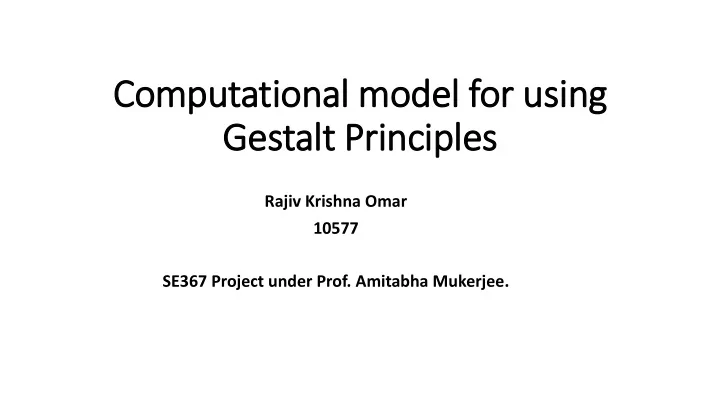

Computational model for using Gestalt Principles Rajiv Krishna Omar 10577 SE367 Project under Prof. Amitabha Mukerjee.
In Introduction Gestalt: • Gestalt is a German word meaning ‘form’ or ‘shape’ • Used for an organized whole that is perceived as more than the sum of its parts Gestalt Principles: • Rule based approach to how humans segment images • Suggests: Eye sees objects in their entirety before its individual parts • Introduced by Wertheimer in 1923 • Further developed by Kohler(1929), Koffka(1935) and Metzger(1936/2006)
Colour Constancy Proximity Continuity Constant Width image source: From gestalt theory to image analysis: a probabilistic approach
Similarity Convexity Perspective image source: From gestalt theory to image analysis: a probabilistic approach
Motivation • Object Segmentation is an important task in vision systems • The amazing simplicity of Gestalt Laws • Gestalt laws requires very little prior information for segmenting image
Previous Work • Introduced by Wertheimer in 1923 • Further developed by Köhler (1929), Koffka (1935) • Ren and Malik in [4] have calculated the values of inter and intra segment texture, brightness and contour energy values and trained a classifier for good or bad segmentation • Kubovy in [5] gives quantitative interpretation in probabilistic settings
Previous Work (Barjatya, Mis isra,2012) • [1] considers the problem of segmentation using Colour Constancy and Continuity Laws • Constructed an database using MS/Paint • Calculated Contrast Feature and Continuum Feature of images • Correct segmentation with 81% accuracy
My Approach • This work will be continuation of work done by Dipendra and Amit • Their algorithm for segmentation using continuity, follows pixels minimizing global gradient and stops if starting point reached Functionality to segment images like above needs to be added
My Approach cont. • Improving on the algorithm for continuity My approach will be use of quadratic curve in place of straight line in global gradient minimization • Adding law of constant width if time permits -It will also improve the segmentation of continuity • Platform: C# on Microsoft Visual Studio 2012 • Dataset: Create new dataset using MS/Paint
Current Status • Generating a image dataset using MS/Paint • We are using code of [1] and are in the process of extending on this code image source: Image from paint datset
References 1. Learning to apply Gestalt Laws by Amit Barjatya, Dipendra Kumar Misra & Amitabha Mukerjee, 2012 2. Book :Desolneux, Agnes, Lionel Moisan, and Jean-Michel Morel. From gestalt theory to image analysis: a probabilistic approach. Vol. 34. Springer, 2007. 3. Dejan Todorovic (2008) Gestalt principles. Scholarpedia, 3(12):5345 4. Learning a Classication Model for Segmentation by Xiaofeng Ren and Jitendra Malik, 2003 5. Kubovy, Michael, and Martin van den Berg. "The whole is equal to the sum of its parts“, 2008
Thank You Questions ?
Im Imple lementation of colo lour constancy • Similar to naive Edge detection algorithm image source: [1]
Implementation of Continuity Law Two Approaches: • Global Continuity • Local Continuity image source: [1]
Cotrast Feature • Contrast Feature is defined for a segment as number of pixels of sharp contrast divided by total number of pixels. • The contrast is measured as the average of difference of pixel values between neighbours and the pixel. Continuum Feature • Sum of one minus the dot products of consecutive tangent vectors divided by 2, as we move across the perimeter of the segment divided by number of pixels on the perimeter
Sample Dataset images Image Source: [1]
Detecting Perceptually Parallel Curves: Criteria and Force-Driven Optimization • Horace H.S. Ip • W.H. Wong a ON THE DETECTION OF PARALLEL CURVES: MODELS AND REPRESENTATIONS by W. H. WONG
Recommend
More recommend